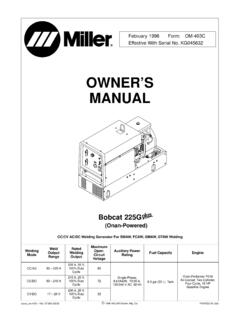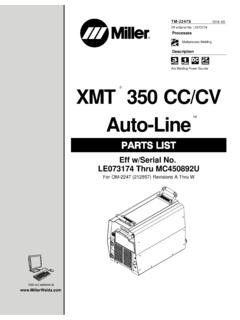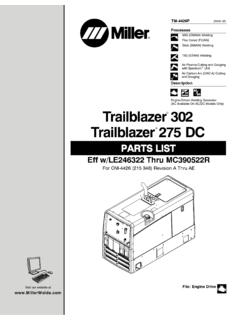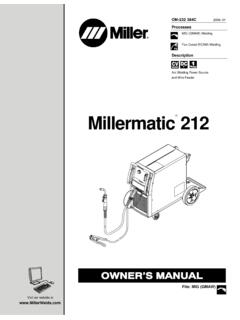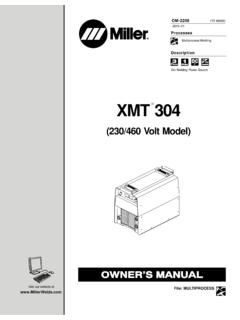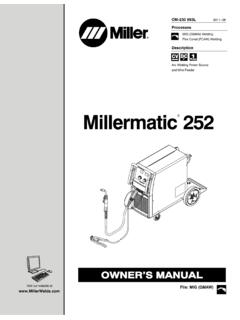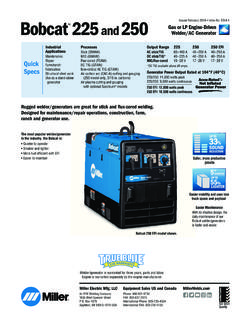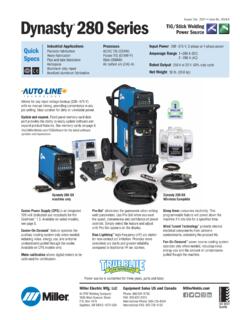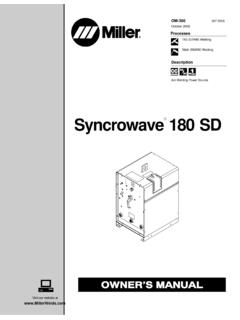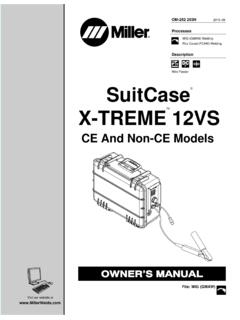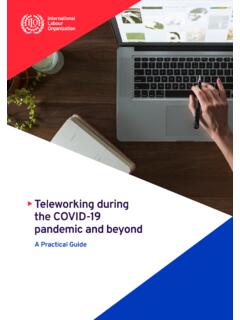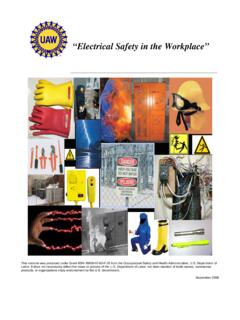Transcription of Guidelines For Resistance Spot Welding - Miller
1 ProcessesDescriptionResistance Spot WelderResistance SpotWelding003335E2018 08 Guidelines ForResistance SpotWeldingFor product information,Owner s Manual translations,and more, OF CONTENTSSECTION 1 SAFETY PRECAUTIONS - READ BEFORE Symbol Resistance Spot Welding Additional Symbols For Installation, Operation, And California Proposition 65 Principal Safety EMF 2 3 FUNDAMENTALS OF Resistance SPOT Heat The Time Electrode Practical Uses Of Resistance Spot Electrode Tip Pressure Or Welding Heat Surface Materials Data For Resistance Spot Mild Low Alloy And Medium Carbon Stainless Steels, Dip Coated Or Aluminum And Aluminum Test 4 MAINTENANCE AND Dressing Page 1 SECTION 1 SAFETY PRECAUTIONS - READ BEFORE USING spotom_2018-01 Protect yourself and others from injury read, follow.
2 And save these important safety precautions and operating Symbol UsageDANGER! Indicates a hazardous situation which, ifnot avoided, will result in death or serious injury. Thepossible hazards are shown in the adjoining symbolsor explained in the a hazardous situation which, if not avoided,could result in death or serious injury. The possiblehazards are shown in the adjoining symbols or ex-plained in the Indicates statements not related to personal injury. Indicates special group of symbols means Warning! Watch Out! ELECTRICSHOCK, MOVING PARTS, and HOT PARTS hazards. Consult sym-bols and related instructions below for necessary actions to avoid Resistance Spot Welding HazardsThe symbols shown below are used throughout this manualto call attention to and identify possible hazards.
3 When yousee the symbol, watch out, and follow the related instructionsto avoid the hazard. The safety information given below isonly a summary of the more complete safety informationfound in the Safety Standards listed in Section 1-5. Read andfollow all Safety qualified persons should install, operate, maintain, andrepair this equipment. A qualified person is defined as onewho, by possession of a recognized degree, certificate, orprofessional standing, or who by extensive knowledge, train-ing and experience, has successfully demonstrated ability tosolve or resolve problems relating to the subject matter, thework, or the project and has received safety training to recog-nize and avoid the hazards operation, keep everybody, especially children, Welding can cause fire or can fly off from the Welding arc.
4 The flyingsparks, hot workpiece, and hot equipment cancause fires and burns. Accidental contact of elec-trode to metal objects can cause sparks, explosion,overheating, or fire. Check and be sure the area is safe before doingany Welding . Remove all flammables within 35 ft ( m) of the weld. If this is notpossible, tightly cover them with approved covers. Do not spot weld where flying sparks can strike flammable material. Protect yourself and others from flying sparks and hot metal. Be alert that Welding sparks can easily go through small cracks andopenings to adjacent areas. Watch for fire, and keep a fire extinguisher nearby.
5 Do not weld on containers that have held combustibles, or onclosed containers such as tanks, drums, or pipes unless they areproperly prepared according to AWS and AWS (seeSafety Standards). Do not weld where the atmosphere can contain flammable dust,gas, or liquid vapors (such as gasoline). Remove any combustibles, such as a butane lighter or matches,from your person before doing any Welding . After completion of work, inspect area to ensure it is free of sparks,glowing embers, and flames. Do not exceed the equipment rated capacity. Use only correct fuses or circuit breakers. Do not oversize orbypass them. Follow requirements in OSHA (a) (2) (iv) and NFPA 51 Bfor hot work and have a fire watcher and extinguisher nearby.
6 Wear body protection made from durable, flame resistant material(leather, heavy cotton, wool). Body protection includes oil-freeclothing such as leather gloves, heavy shirt, cuffless trousers, highshoes, and a live electrical parts can cause fatal shocksor severe burns. The input power circuit andmachine internal circuits are also live when power ison. Incorrectly installed or improperly groundedequipment is a SHOCK can kill. Do not touch live electrical parts. Wear dry, hole-free insulating gloves and body protection. Additional safety precautions are required when any of the followingelectrically hazardous conditions are present: in damp locations orwhile wearing wet clothing; on metal structures such as floors, grat-ings, or scaffolds; when in cramped positions such as sitting,kneeling, or lying; or when there is a high risk of unavoidable or acci-dental contact with the workpiece or ground.
7 For these conditions,see ANSI listed in Safety Standards. And, do not work alone! Disconnect input power before installing or servicing this equip-ment. Lockout/tagout input power according to OSHA 29 (see Safety Standards). Properly install, ground, and operate this equipment according tothis manual and national, state, and local codes. Always verify the supply ground check and be sure that input pow-er cord ground wire is properly connected to ground terminal indisconnect box or that cord plug is connected to a properlygrounded receptacle outlet. When making input connections, attach the grounding conductorfirst double-check connections.
8 Keep cords dry, free of oil and grease, and protected from hot metaland sparks. Frequently inspect input power cord and ground conductor for dam-age or bare wiring replace immediately if damaged bare wiringcan kill. Turn off all equipment when not in use. For water-cooled equipment, check and repair or replace any leak-ing hoses or fittings. Do not use any electrical equipment if you arewet or in a wet area. Use only well-maintained equipment. Repair or replace damagedparts at once. Wear a safety harness if working above floor level. Keep all panels, covers, and guards securely in Page 2 Very often sparks fly off from the joint area.
9 Wear approved face shield or safety goggleswith side SPARKS can injure. Wear body protection made from durable, flame resistant material(leather, heavy cotton, wool). Body protection includes oil-freeclothing such as leather gloves, heavy shirt, cuffless trousers, highshoes, and a cap. Protect others in nearby areas by using approved flame-resistant ornoncombustible fire curtains or shields. Have all nearby personswear safety glasses with side shields. Do not touch hot parts bare handed. Allow cooling period before working onequipment. To handle hot parts, use proper tools and/or wear heavy, insu-lated Welding gloves and clothing to prevent PARTS can tong tips, tongs, and linkages move duringoperation.
10 Keep away from moving PARTS can injure. Keep away from pinch points. Do not put hands between tips. Keep all guards and panels securely in place. OSHA and/or local codes can require additional guarding to suit produces fumes and gases. Breathingthese fumes and gases can be hazardous to AND GASES can be hazardous. Keep your head out of the fumes. Do not breathe the fumes. Ventilate the work area and/or use local forced ventilation at the arcto remove Welding fumes and gases. The recommended way to de-termine adequate ventilation is to sample for the composition andquantity of fumes and gases to which personnel are exposed.
